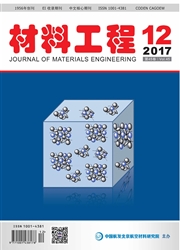

 中文摘要:
中文摘要:
基于红外热像法对AZ31B镁合金板材室温下的高周疲劳性能进行了研究.使用红外热成像仪测量整个疲劳过程中试件表面温度变化.结果表明:镁合金疲劳加载过程中的温度变化分为初始温度增加、温度降低、温度恒定、温度快速上升、温度最后下降5个部分.采用基于热传导、热弹性和非弹性效应的理论模型解释了疲劳加载过程中的温度变化.红外热像法预测的AZ31B镁合金疲劳极限113MPa与实验结果108MPa相对误差约为4.8%.基于镁合金表面温度的变化,提出了△Tmax-N曲线预测疲劳寿命的方法,即通过测量阶段Ⅰ温升最大值预测镁合金的疲劳断裂,并计算其疲劳寿命.
 英文摘要:
英文摘要:
High-cycle fatigue damage process of AZ31B magnesium alloy at room temperature was studied based on thermographic technology.An infrared-thermography camera was used to investigate the temperature evolution on the surface of material during fatigue experiments.Results show that the temperature evolution mainly undergoes five stages under fatigue loading:an initial increase,steep re duces,steady state,an abrupt increase and final drop (stage Ⅴ).Theoretical model combining the thermoelastic,inelastic,and heat-transfer effects will be formulated to explain the temperature pro files observed during fatigue.The relative error of fatigue limits between the experimental result (108MPa) and the predicted result (113MPa) is 4.8%.△Tmax-N curve was proposed to predict the fatigue life based on the temperature evolution during the fatigue experiments.The fatigue fracture and the fatigue life will be predicted by maximum temperature rise of first stage.
 同期刊论文项目
同期刊论文项目
 同项目期刊论文
同项目期刊论文
 An experimental analysis of fatigue behavior of AZ31B magnesium alloy welded joint based on infrared
An experimental analysis of fatigue behavior of AZ31B magnesium alloy welded joint based on infrared Fatigue life prediction of AZ31B magnesium alloy and its welding joint through infrared thermography
Fatigue life prediction of AZ31B magnesium alloy and its welding joint through infrared thermography Rapid determination for fatigue parameters of AZ31B magnesium alloy based on evolution of temperatur
Rapid determination for fatigue parameters of AZ31B magnesium alloy based on evolution of temperatur 期刊信息
期刊信息
